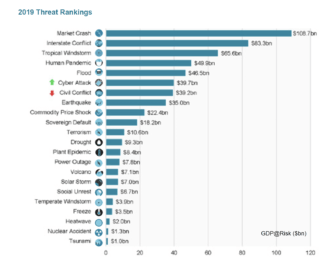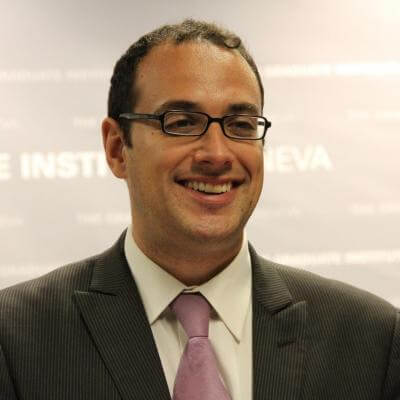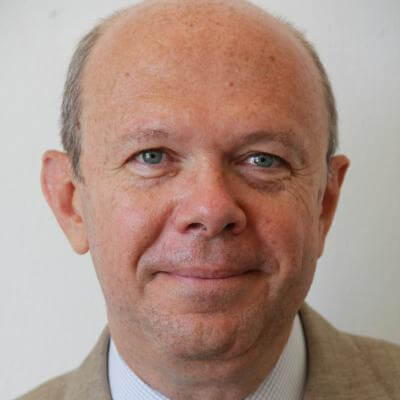The Paradox of Risk in an Age of Global Contraction
Risk may be defined as a tension between a reality linked to a potential danger and the perception of this danger. It would, however, be erroneous to reduce risk to a simple calculus as it is historically, culturally and socially mediated. Both reality and perception of dangers have evolved over time, among others because the relationship to death – that most ultimate of risks – has changed and new technologies have emerged. In preindustrial societies risk was omnipresent, as invasions, wars, famines or epidemics punctuated the daily lives of populations. Fatality prevailed, as calamities were perceived as pre-ordained by natural order or godly will and risks were sublimated through myths, religion or witch-hunts. Certain sectors of society, however, specialised in risk-taking, such as knights whose sense of honour depended on bravery in combat or seafarers who would risk their lives at sea.
Modernity’s Ambivalent Relation to risk
Enlightenment’s new, forward-looking approach to temporality and promotion of human agency and freedom profoundly transformed mankind’s relationship to risk. It set humanity on a frantic flight forward in pursuit of progress, innovation and social transformation. Capitalism, the ideology of (early) bourgeois entrepreneurship, put a premium on risk-taking – as a return on investment, a reward to successful competitors – and created financial markets to trade, broker and insure risks.
 FIGURE 1 | 2019 THREAT RANKINGS. Risk to economic output from 22 types of threats providing GDP@Risk estimates as a standardised metric for 279 different cities.
FIGURE 1 | 2019 THREAT RANKINGS. Risk to economic output from 22 types of threats providing GDP@Risk estimates as a standardised metric for 279 different cities.While successful in its efforts at domesticating old risks that had plagued mankind since its inception, modernity’s utilitarian impetus and instrumental approach to nature set loose new, potentially devastating risks in the form of man-made calamities such as weapons of mass destruction, resource depletion, financial crashes or climate change.
Concomitantly, Enlightenment’s analytical impetus foreshadowed the modern techniques of risk management based on the premise that risks can be endlessly broken down, measured, segmented, anticipated, controlled, and mitigated. Today, risk management has become a massive industry employing an armada of venture capitalists, brokers, (re-)insurers, consultants, and rank and file managers relying on risk matrixes, metrification, statistical projections, actuarial science, and computer-modelling to predict, administrate, repackage or sell risks.
 FIGURE 2 | TOP 10 RISKS IN TERMS OF LIKELIHOOD AND IMPACT. Read more on WEF’s webpage “The Global Risks Landscape 2020”.
FIGURE 2 | TOP 10 RISKS IN TERMS OF LIKELIHOOD AND IMPACT. Read more on WEF’s webpage “The Global Risks Landscape 2020”.Through the accumulation of massive surpluses of capital and wealth and the increased intervention of the state and its regulatory apparatus, industrial societies eventually were in a position to relax as they domesticated, internalised and evacuated risks from everyday life. This easing up, however, led to the paradox that while capitalism is based on risk-taking, neoliberal societies and markets, in their relentless pursuit of a risk-free utopia, have become oligopolistic, risk-averse, and obsessed with control. While capitalism is based on risk-taking, neoliberal societies and markets, in their relentless pursuit of a risk-free utopia, have become oligopolistic, risk-averse, and obsessed with control. They breed conformity instead of creativity and innovation. A culture of risk avoidance and “precautionism” has thus taken precedence, to the extent that we are seemingly no longer in a position to handle the unexpected and cope with major self-induced (war, economic crisis) or external (epidemics, earthquakes) cataclysms.
New Risks on the Horizon
The COVID crisis, as a revenge of nature, has profoundly shaken societies worldwide and contributed to a reconfiguration – perhaps a multiplication – of risks. Even though a vaccine has now been found, people’s perceptions of the danger they run from COVID-19, or other viruses, are likely to persist for years. By the same token, the pandemic is likely to carry in its wake heightened perception of other risks, ranging from long-term economic disruption to psychological distress and political confrontation.
COVID-19 has triggered a real risk of economic breakdown and social crisis aggravating the seemingly unstoppable downward trends of growing inequality and eroding welfare states. Unsurprisingly, the pandemic has also stirred political unrest as anxiety and uncertainty loom large. Nationalists, identitarians and illuminati of all sorts and colours are emboldened by the closing of borders, looming trade wars, blossoming conspiracy theories, and the stigmatisation of alterity.
Deeper, structural forces have, however, been at play, reconfiguring the global landscape of risk long before the outbreak of the pandemic. The internationalisation of fear – fuelled by new communication strategies and technologies – has been ongoing since the War on Terror campaign launched by G.W. Bush. The coarsening of international politics has been accelerated by Donald Trump and his illiberal acolytes as security issues such as proliferation are magnified by the multiplication of rogue states and non-sate actors.
Despite the availability of big data and powerful means of forecasting and statistical modelling, uncertainty and unpredictability remain pervasive. The looming collapse of temporality due to a seeming hyperinflation of the present obfuscates our access to the past and thus our ability to anticipate the future. Technology, while hitherto a key catalysator of risk mitigation and management, is increasingly becoming a risk itself, as illustrated by issues of gene screenings, cloning, cybersecurity, autonomous weapons and the so-called artificial intelligence.Despite the availability of big data and powerful means of forecasting and statistical modelling, uncertainty and unpredictability remain pervasive.
While the risk that algorithms may ultimately emancipate themselves from humans and lead a life of their own seems low, the risk related to – purposefully or not – inbuilt biases or functional disconnect between those who design algorithms and those who apply them is much more tangible, as illustrated by the financial crisis of 2007. Digitalisation also poses obvious risks to democracy by fragmenting political discourse, trapping citizens into endless self-referential bubbles and exposing them to monitoring, censorship or foreign manipulation. The most pressing risk remains, however, environmental degradation as it threatens mankind’s – and all other living creature’s – living space and means of existence.
Looking beyond Risks
The nature and frontiers of risks are moving and it is questionable whether current risk mitigation strategies are still adapted. The nature and frontiers of risks are moving and it is questionable whether current risk mitigation strategies are still adapted. Too much emphasis has been put on technical solutions and model-based forecasts ignoring the social embeddedness and cultural construction of risk. To add to injury, the multilateral system, the most adequate framework to deal with global risks, is ailing. The question thus arises, as formulated by Aditya Bharadwaj in this issue, whether continuously deferring risk to the future is not, ultimately, self-defeating since the hope to harness the unforeseen constantly eludes us. Rather than seeking to eliminate risks once and for all, or deferring them with arcane mitigation plans and insurance schemes, it may indeed be time to pause and contemplate the structural issues that gestate the ills of our world in the here and now. The final frontier of risk might, indeed, consist in the reification of reason or, to put it with Theodor Adorno in Dialectic of Enlightenment, in that “on the way from mythology to logistics, thought has lost the element of self-reflection”.
The present dossier, based on the contributions of six researchers from the Graduate Institute, explores new and old risks in the fields of finance, biomedicine, environment, health and the internet. It seeks to answer how hierarchies of risk (and their perception) are reconfiguring in the wake of COVID and how policymakers are aiming to redefine and balance them.
-
1
 Moment of Surprise: The Anatomy of Biomedical Risk
Moment of Surprise: The Anatomy of Biomedical RiskAs the emergence and rapid spread of coronavirus show, pandemic preparedness can anticipate biomedical risks but never quite pre-empt them. More generally, human imagination can never anticipate the moment of surprise, when risk moves from the realm of active imagination to concrete manifestation. The only temporal dimension in which potential risks can be meaningfully understood is the “here and now”, argues Aditya Bharadwaj.
-
2
 Finance and Risk over the Long Run
Finance and Risk over the Long RunAfter tracing the expansion of financial risk-mitigating strategies from the Middle Ages to now, Ruy Esteves reflects on the need for more resilient strategies and more flexible and collaborative decision-making to prepare for future uncertainty.
-
3
 Systemic Risk in the Financial System
Systemic Risk in the Financial SystemTen years after the financial crisis of 2008, and faced with the disruptions brought by the COVID pandemic, are we about to face another wave of financial crises? Furthermore, asks Cédric Tille, how should we react to the pandemic while keeping in mind the financial consequences of long-term challenges such as climate change?
-
4
 Understanding Global Environmental and Health Risks in the 21st Century
Understanding Global Environmental and Health Risks in the 21st CenturyOur inability to deal with environmental change comes in part from the habit of thinking in small specialised boxes. For Gian Luca Burci and Jorge Viñuales, knowledge integration and appropriate levels of description are key conditions for us not to be mere spectators of an environmental “risk” we can indeed address.
-
5
 Risky Entanglements between States and Online Platforms
Risky Entanglements between States and Online PlatformsWhile online platforms attach little importance to the protection of privacy and the prevention of disinformation, governments use platforms to pursue economic or “security” goals. Jérôme Duberry highlights how the relationship between states and online platforms presents a major risk for the populations and the legitimacy of national and international public institutions.
PODCAST | The Unlikely Hierarchy of Health Risk – Ryan Whitacre
Research Office, The Graduate Institute, Geneva.
PODCAST | La globalisation des diversités – Fabrizio Sabelli
Research Office, The Graduate Institute, Geneva.
PODCAST | AI, Big Data, and Big Risk? Michael Kende
Research Office, The Graduate Institute, Geneva.
PODCAST | The Fabrication of Terrorism Risk – Andrea Bianchi
Research Office, The Graduate Institute, Geneva.








